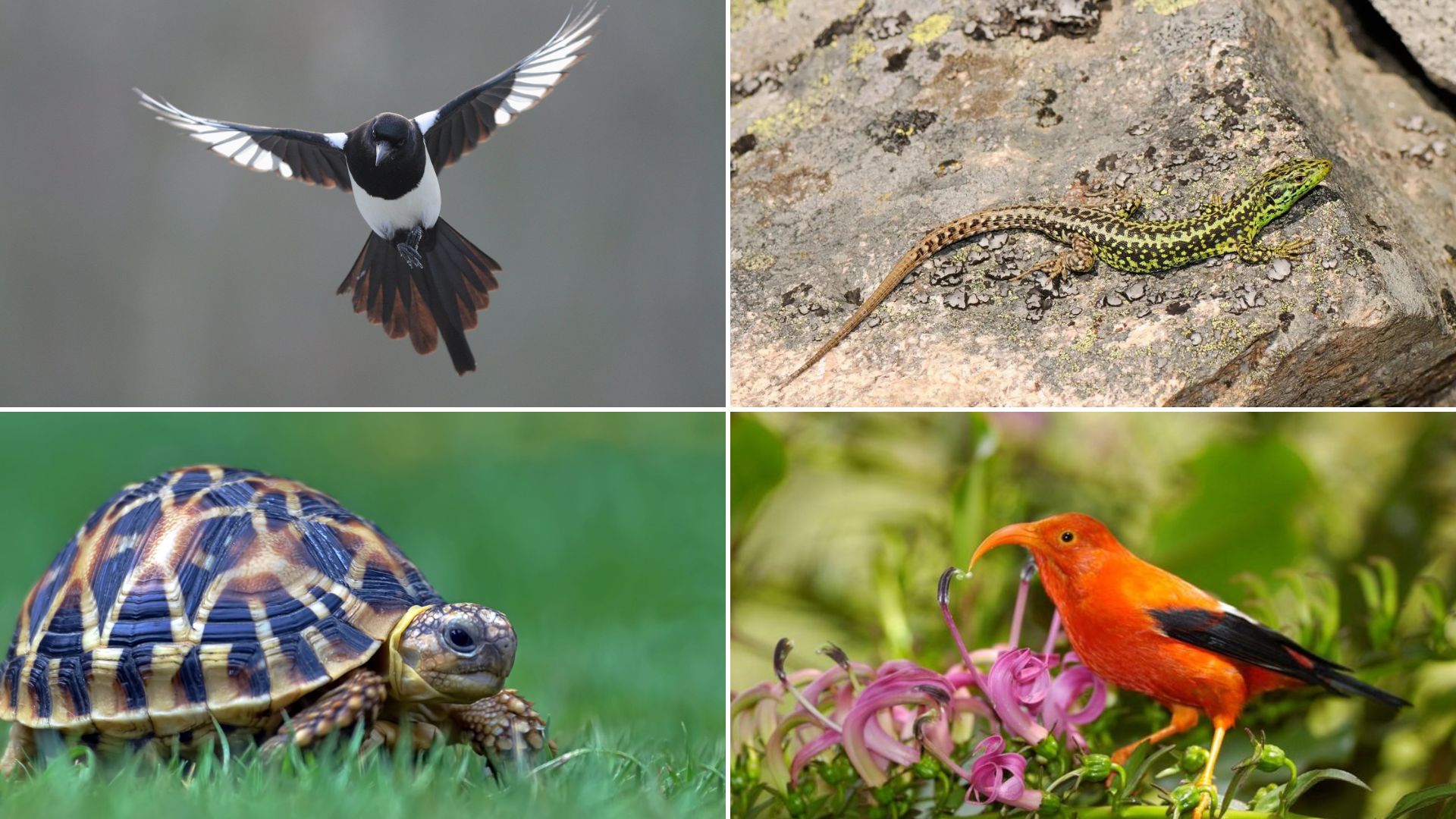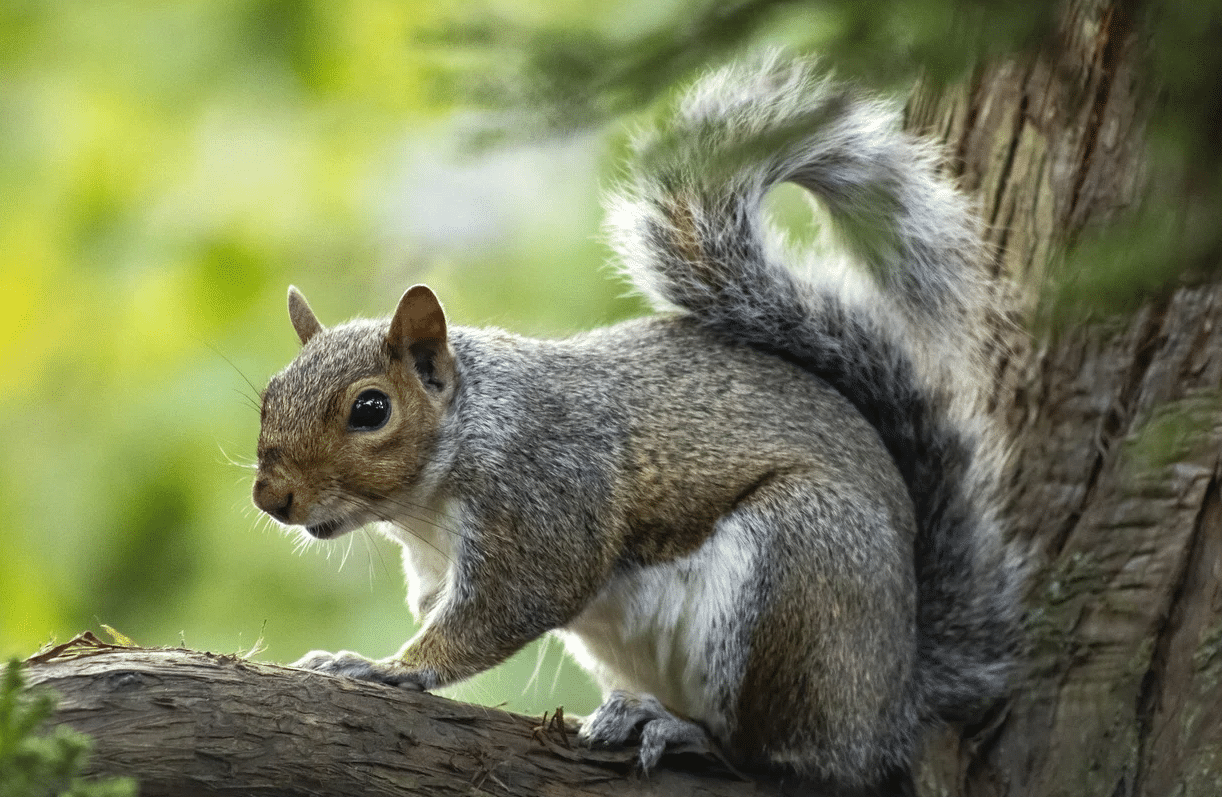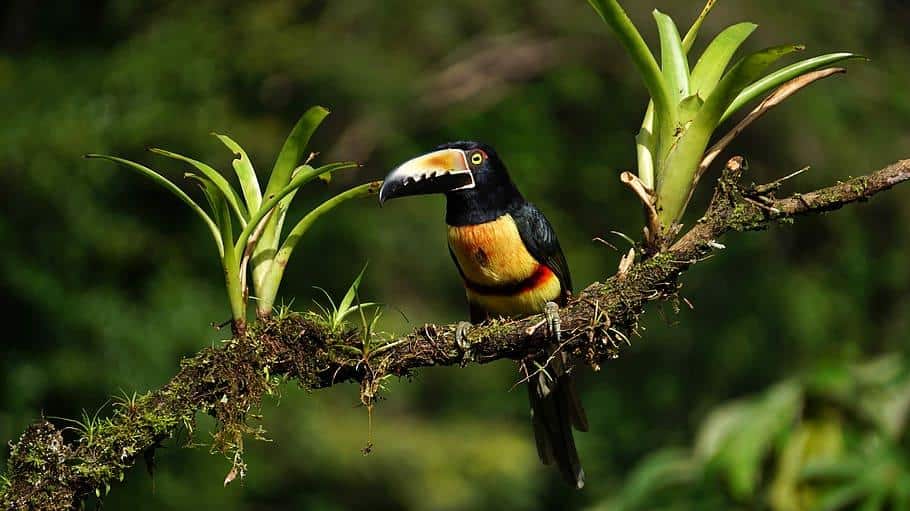Most people can name common animals like lions or elephants. But when it comes to animals starting with “I,” many draw a blank. This gap in knowledge means missing out on some of nature’s most interesting creatures.
This blog will introduce readers to remarkable animals whose names begin with “I.” From tiny insects to massive mammals, these creatures showcase amazing abilities and behaviors that will surprise anyone.
Each section covers the animal’s appearance, habitat, and what makes it special. By the end, they’ll have expanded their animal knowledge and gained a new appreciation for wildlife diversity. Some of these creatures might even become their new favorites.
Intriguing Animals That Start with the Letter ‘I’
Animals that start with the letter ‘I’ often possess unique adaptations and interesting behaviors that set them apart in the animal kingdom. Their diversity spans various habitats, from dense forests to vast oceans, showcasing nature’s creativity and resilience.
1. Ibex
The ibex is a wild goat known for its impressive horns and remarkable climbing abilities. These agile mountaineers are well-adapted to rugged, rocky terrains.
- Place of Origin: mountainous regions of Europe, Asia, and North Africa
- Regions of Habitat: Alpine areas, rocky slopes, and cliffs across their native range
- Scientific Name: Capra ibex
Interesting Facts: Ibex can easily travel across narrow ledges and climb up nearly vertical rocky surfaces, thanks to their specialized hooves, which provide excellent traction. Their large, curved horns are used for defense and establishing dominance during mating season.
2. Iguana
Iguanas are large, docile lizards found in tropical regions of the Americas. These reptiles are well-known for their distinctive appearance and ability to change color.
- Place of Origin: Mexico, Central America, South America, and the Caribbean
- Regions of Habitat: Tropical rainforests, dry forests, and coastal areas
- Scientific Name: Iguana iguana
Interesting Facts: Iguanas are excellent swimmers and can remain underwater for up to 30 minutes. When threatened, they can detach their tails and grow new ones, a process known as caudal autotomy. Some iguana species can change color to regulate their body temperature or communicate.
3. Impala
The Impala is a graceful, medium-sized antelope found in the savannas and woodlands of Africa. Known for their impressive leaping abilities, these elegant creatures are a delight to observe.
- Place of Origin: Southern and East Africa
- Regions of Habitat: Savannas, grasslands, and open woodlands across their native range
- Scientific Name: Aepyceros melampus
Interesting Facts: Impalas can leap over 3 meters (10 feet) high and 9 meters (30 feet) horizontally, making them incredibly agile when evading predators. Males have lyre-shaped horns and engage in spectacular displays of strength and agility during mating season.
4. Indri
The indri is the largest living lemur species, found exclusively in the rainforests of Madagascar. These gentle primates are known for their distinctive loud calls that can be heard from miles away.
- Place of Origin: Madagascar
- Regions of Habitat: Rainforests of eastern Madagascar
- Scientific Name: Indri indri
Interesting Facts: Indris are diurnal, meaning they are active during the day and spend most of their time resting and sunbathing in the trees. Their loud, haunting calls are used to defend their territory and communicate with other groups. They are critically endangered due to habitat loss.
5. Iberian Psammodromus
The Iberian Psammodromus is a small lizard species found on the Iberian Peninsula, which spans parts of Spain and Portugal. These agile reptiles are well-adapted to their arid and rocky habitats.
- Place of Origin: Iberian Peninsula
- Regions of Habitat: Dry, rocky areas, scrublands, and sandy areas in Spain and Portugal
- Scientific Name: Psammodromus hispanicus
Interesting Facts: The Iberian Psammodromus is a type of sand lizard with a sleek, streamlined body and long tail that aids in balance and agility. They are excellent climbers and can move swiftly across rocky surfaces and through vegetation.
These lizards are well-camouflaged, with coloration ranging from shades of brown to gray, helping them blend into their arid surroundings. They feed on various small insects, spiders, and other invertebrates.
Despite their small size, these lizards are known for their bold behavior and will readily defend their territories from intruders. Conservation efforts are focused on protecting their habitats from urbanization and other threats.
6. Irrawaddy Dolphin
The Irrawaddy dolphin is a rare and endangered dolphin found in some rivers and coastal areas of Southeast Asia. These intelligent marine mammals are adapted to both freshwater and brackish environments.
- Place of Origin: Southeast Asia
- Regions of Habitat: Rivers, estuaries, and coastal waters of the Irrawaddy River (Myanmar), Mekong River, and other areas
- Scientific Name: Orcaella brevirostris
Interesting Facts: Irrawaddy dolphins are easily recognizable because of their unique round, bulging forehead and short beak. They are known for their playful and curious behavior toward humans. Unfortunately, their populations are dwindling due to habitat loss, pollution, and bycatch in fishing nets.
7. Iberian Lynx
The Iberian lynx is a critically endangered wild cat species found exclusively in the Iberian Peninsula of Spain and Portugal. These elusive felines are known for their distinctive spotted coats and tufted ears.
- Place of Origin: Iberian Peninsula (Spain and Portugal)
- Regions of Habitat: Mediterranean forests, shrublands, and grasslands in southern Spain and Portugal
- Scientific Name: Lynx pardinus
Interesting Facts: The Iberian lynx is one of the most endangered cat species in the world, with fewer than 500 individuals remaining in the wild. They are specialized hunters of rabbits and hares. Conservation efforts, including captive breeding programs and habitat protection, are ongoing to prevent their extinction.
8. Ibisbill
The ibisbill is a unique and enigmatic bird found in the mountain streams of central Asia. With its long, curved bill and unusual behavior, it has long puzzled ornithologists.
- Place of Origin: Central Asia
- Regions of Habitat: Mountainous regions of India, Pakistan, Nepal, Bhutan, and China
- Scientific Name: Ibidorhyncha struthersii
Interesting Facts: The ibisbill is adapted to live in fast-flowing mountain streams. Its long, curved bill probes under rocks and captures aquatic insects and crustaceans. Despite its name, it is not closely related to ibises. These birds are excellent swimmers and can even walk on the riverbed underwater.
9. Inca Tern
The Inca tern is a striking seabird found along the western coasts of South America. This tern is a remarkable aerial hunter known for its distinctive mustache-like markings.
- Place of Origin: Western South America
- Regions of Habitat: Coastal regions of Peru, Chile, and Ecuador
- Scientific Name: Larosterna inca
Interesting Facts: Inca terns are highly social birds that nest in dense colonies on rocky outcrops and cliffs. They feed by plunging into the ocean to catch small fish and squid. Their unique mustache-like markings and bright red-orange bill make them easily recognizable in flight.
10. Indochinese Tiger
The Indochinese tiger is a critically endangered subspecies of tiger found in the forests of Southeast Asia. These powerful predators are known for their reddish-orange coats and striking black stripes.
- Place of Origin: Southeast Asia
- Regions of Habitat: Tropical and subtropical forests of Thailand, Myanmar, Laos, Vietnam, and Cambodia
- Scientific Name: Panthera tigris corbetti
Interesting Facts: Indochinese tigers are solitary and territorial, with each individual having a home range of up to 300 square kilometers. They play a crucial role in maintaining the balance of their ecosystems by regulating prey populations. Habitat loss, poaching, and fragmentation have pushed these magnificent cats to the brink of extinction.
11. Indian Pangolin
The Indian pangolin is a unique, scaly mammal in parts of the Indian subcontinent. It is well-adapted for its insectivorous diet and eats ants and termites.
- Place of Origin: Indian Subcontinent
- Regions of Habitat: Semi-arid regions, grasslands, and forests of India, Pakistan, Bangladesh, and Sri Lanka
- Scientific Name: Manis crassicaudata
Interesting Facts: Pangolins are covered in tough, overlapping scales made of keratin, the same material as human fingernails. These scales act as armor, allowing them to roll into a tight ball when threatened. Indian pangolins use their long, sticky tongues to feed on ants and termites found in underground nests and mounds.
12. Indian Rhino
The Indian rhinoceros, also known as the greater one-horned rhinoceros, is a massive, armored mammal in parts of the Indian subcontinent. These prehistoric-looking animals are iconic symbols of conservation efforts.
- Place of Origin: Indian Subcontinent
- Regions of Habitat: Grasslands, swampy areas, and forests of northeastern India and Nepal
- Scientific Name: Rhinoceros unicornis
Interesting Facts: Despite their massive size and weight, Indian rhinos are excellent swimmers and can even run up to 55 km/h for short bursts. They use their huge horns for defense, territory marking, and food foraging. Conservation efforts have helped increase their numbers from just a few hundred in the early 20th century.
13. Indian Leopard
The Indian leopard is a subspecies of leopard found across the Indian subcontinent. These powerful and stealthy big cats are highly adaptable and thrive in various habitats.
- Place of Origin: Indian Subcontinent
- Regions of Habitat: Forests, grasslands, and even urban areas across India, Pakistan, Nepal, and Bangladesh
- Scientific Name: Panthera pardus fusca
Interesting Facts: Indian leopards are solitary, nocturnal hunters known for their exceptional climbing abilities. They can drag prey up to three times their weight into trees. Despite being threatened by habitat loss and human-wildlife conflict, these leopards have found ways to coexist in some urban areas, adapting to thrive in human-dominated landscapes.
14. Indian Peafowl
The Indian peafowl, also known as the blue peafowl, is a large, vibrant bird species native to the Indian subcontinent. The males are renowned for their stunning, iridescent plumage and elaborate courtship displays.
- Place of Origin: Indian Subcontinent
- Regions of Habitat: Semi-arid grasslands, deciduous forests, and cultivated areas in India, Pakistan, and Sri Lanka
- Scientific Name: Pavo cristatus
Interesting Facts: Indian peafowl are famous for their extravagant train of elongated feathers, which the males fan out during courtship displays to attract females. These displays involve intricate movements, vocalizations, and the shaking of the train feathers. The peafowl is the national bird of India and has significant cultural and religious symbolism.
15. Indian Elephant
The Indian elephant is one of three recognized subspecies of the Asian elephant, native to the Indian subcontinent. These massive mammals are revered in Indian culture and play vital roles in their ecosystems.
- Place of Origin: Indian Subcontinent
- Regions of Habitat: Forests, grasslands, and scrublands across India, Bangladesh, Bhutan, Nepal, and parts of Southeast Asia
- Scientific Name: Elephas maximus indicus
Interesting Facts: Indian elephants are smaller than their African counterparts but are still the largest land mammals in Asia. They are highly intelligent and social animals, living in close-knit matriarchal herds led by the oldest female. Their large size and appetite make them keystone species, helping to shape and maintain their habitats.
16. Indian Muntjac
The Indian muntjac, or barking deer, is a small species in parts of the Indian subcontinent and Southeast Asia. It is known for its distinctive barking calls and relatively large canine teeth.
- Place of Origin: Indian Subcontinent and Southeast Asia
- Regions of Habitat: Forests, grasslands, and hilly areas of India, Sri Lanka, Bangladesh, Myanmar, Thailand, and other parts of Southeast Asia
- Scientific Name: Muntiacus muntjak
Interesting Facts: Indian muntjacs are solitary and territorial animals, using their loud, dog-like barks to communicate and defend their territories.
Despite their small size, the males have elongated upper canine teeth that protrude from their mouths, which they use for fighting and displays. These deer are excellent swimmers and can even walk on the bottom of shallow streams.
17. Indian Gharial
The Indian gharial is a critically endangered crocodilian species found in the rivers of the Indian subcontinent. These unique reptiles are easily recognized by their long, slender snouts and distinctive bulbous growths at the end of their snouts.
- Place of Origin: Indian Subcontinent
- Regions of Habitat: Rivers and freshwater systems of northern India and Nepal
- Scientific Name: Gavialis gangeticus
Interesting Facts: Indian gharials are highly specialized fish-eaters, using their long, thin snouts to catch fish in the water. The bulbous growths at the end of the males’ snouts are used for vocalization during mating season.
Once widespread, their populations have declined dramatically due to factors like hunting, egg collection, and habitat loss. Intensive conservation efforts are underway to prevent their extinction.
18. Iguana Blue
The iguana blue is a vibrant, medium-sized lizard in the Caribbean region. These arboreal reptiles are known for their striking blue coloration and ability to change color.
- Place of Origin: Caribbean
- Regions of Habitat: Islands of the Caribbean, including Bahamas, Cuba, Jamaica, and the Cayman Islands
- Scientific Name: Cyclura lewisi
Interesting Facts: Iguana blues are excellent climbers and spend much of their time in trees and shrubs. They can change their color from a dull grayish-brown to a brilliant blue, which is thought to be a means of communication and temperature regulation.
These lizards are herbivores, feeding primarily on leaves, flowers, and fruits. Conservation efforts have helped protect their populations on some islands.
19. Iberian Ibex
The Iberian ibex is a wild goat species found in the mountainous regions of the Iberian Peninsula. These nimble climbers are well-adapted to their rugged, rocky habitats.
- Place of Origin: Iberian Peninsula (Spain and Portugal)
- Regions of Habitat: Mountainous areas of Spain, Portugal, and southern France
- Scientific Name: Capra pyrenaica
Interesting Facts: Iberian ibexes are excellent climbers, easily navigating cliffs and rocky terrain thanks to their specialized hooves and agility.
The males have large, curved horns for display and defense during the mating season. Conservation efforts have helped bring this species back from the brink of extinction in the late 20th century.
20. Icterine Warbler
The icterine warbler is a small songbird that breeds across Europe and western Asia and migrates to sub-Saharan Africa for the winter. It is known for its bright yellow plumage and distinctive songs.
- Place of Origin: Europe and Western Asia
- Regions of Habitat: Woodlands, forests, and parks during breeding season; sub-Saharan Africa during winter
- Scientific Name: Hippolais icterina
Interesting Facts: Icterine warblers get their name from their vibrant yellow coloring, which is more pronounced in males during the breeding season. These birds are excellent singers, with a loud, rich song that can be heard throughout their woodland habitats.
Despite their bright colors, they are well-camouflaged when foraging among the leaves and branches of trees and shrubs. Icterine warblers are long-distance migrants, making an annual journey of over 5,000 miles between their breeding and wintering grounds.
Their populations are considered stable, but they face threats from habitat loss, particularly in their African wintering areas
21. Iriomote Cat
The Iriomote cat is a critically endangered wildcat species found exclusively on the Japanese island of Iriomote. These elusive felines are among the rarest and least-known cat species worldwide.
- Place of Origin: Iriomote Island, Japan
- Regions of Habitat: Subtropical forests and mangrove swamps of Iriomote Island
- Scientific Name: Prionailurus bengalensis iriomotensis
Interesting Facts: Iriomote cats are believed to be a subspecies of the Leopard cat, but their genetic distinctiveness is still being studied. These small wildcats are highly secretive and nocturnal, making studying in the wild difficult.
Estimates suggest fewer than 100 individuals remain due to habitat loss, hunting, and other threats. Intensive conservation efforts are underway to protect this rare feline species.
22. Iberian Mole
The Iberian mole is a small, subterranean mammal species found on the Iberian Peninsula. These burrowing creatures are well-adapted for underground life.
- Place of Origin: Iberian Peninsula (Spain and Portugal)
- Regions of Habitat: Grasslands, meadows, and agricultural areas across Spain and Portugal
- Scientific Name: Talpa occidentalis
Interesting Facts: Iberian moles have cylindrical bodies, sharp claws, and tiny eyes that are well-suited for their underground lifestyle. They create extensive tunnel systems in search of earthworms, insects, and other invertebrates to eat.
These moles are important in aerating and turning over the soil in their habitats. Despite their prevalence, they are rarely seen above ground due to their secretive, underground existence.
23. Ibiza Wall Lizard
The Ibiza wall lizard is a small reptile species found exclusively on the Spanish island of Ibiza. These agile lizards are well-adapted to life in the island’s rocky and arid habitats.
- Place of Origin: Ibiza, Spain
- Regions of Habitat: Rocky areas, stone walls, and dry shrublands on the island of Ibiza
- Scientific Name: Podarcis pityusensis
Interesting Facts: The Ibiza wall lizard is a subspecies of the Balearic wall lizard, adapted to the specific conditions of Ibiza. These lizards are excellent climbers and can often be seen basking on rocks and stone walls.
Their coloration ranges from gray to brown, helping them blend into their rocky surroundings. They feed on various small insects and are important to the island’s ecosystem.
24. Ida’s Blue Butterfly
Ida’s blue butterfly is a rare and beautiful butterfly found only in a small region of central Russia. These delicate insects are named after a famous Russian naturalist.
- Place of Origin: Central Russia
- Regions of Habitat: Meadows and forest glades in the Vladimir and Nizhny Novgorod regions of Russia
- Scientific Name: Plebejus idas
Interesting Facts: Ida’s blue butterflies have iridescent blue wings with black spots and margins. The undersides of the wings are grayish with distinct black spots. These butterflies feed on the nectar of wildflowers during their short adult lifespans.
The caterpillars feed exclusively on a few species of legume plants. Due to their extremely limited range and threats like habitat loss, Ida’s blue is considered one of Europe’s most endangered butterfly species.
25. Iguanodon
The Iguanodon was a large herbivorous dinosaur that lived around 126-113 million years ago during the early Cretaceous period.
- Place of Origin: Europe
- Regions of Habitat: Widespread across Europe, northern Africa, and possibly eastern North America during the early Cretaceous
- Scientific Name: Iguanodon
Interesting Facts: Iguanodon was one of the first scientifically identified and named dinosaurs. These plant-eaters could grow up to 10 meters (33 feet) long and weigh several tons. They walked on their hind legs with a thumb spike on each hand. Their unique tooth structure suggests they may have chewed their food like modern mammals and birds.
26. Irish Elk
The Irish elk, also known as the giant deer, was an impressive and now-extinct species of deer that once roamed parts of Europe and Asia. These massive creatures are known for their enormous antlers.
- Place of Origin: Europe and Asia
- Regions of Habitat: Formerly found in areas across Europe, including Ireland, as well as parts of Asia
- Scientific Name: Megaloceros giganteus
Interesting Facts: The Irish elk was one of the largest deer species ever, with males reaching heights of up to 2 meters (6.5 feet) at the shoulder. Their most distinctive feature was their massive antlers, which could span over 3 meters (10 feet) in width – the largest of any known deer species.
These antlers were used for display and defense. The Irish elk went extinct around 7,700 years ago, likely due to climate change, habitat loss, and overhunting.
27. Island Wren
The island wren is a small songbird species found on several islands off the coast of Mexico. These tiny birds are well-adapted to their unique island habitats.
- Place of Origin: Islands off the Pacific coast of Mexico
- Regions of Habitat: Socorro, Clarión, and other islands in the Revillagigedo Archipelago
- Scientific Name: Troglodytes tanneri
Interesting Facts: The island wren is one of the smallest wren species in the world, measuring only about 10-12 cm (4-5 inches) in length. Despite their diminutive size, these birds have loud, distinctive calls that can be heard throughout their island habitats.
They feed on insects and spiders, using their slender, curved bills to probe crevices and foliage. Conservation efforts are focused on protecting their limited island habitats from invasive species and human disturbance.
28. Ivory Gull
The ivory gull is a striking all-white seabird species in the high Arctic regions. These birds are well-adapted to the harsh conditions of the polar environment.
- Place of Origin: Arctic regions
- Regions of Habitat: Coastal areas, pack ice, and open waters of the high Arctic, including Canada, Greenland, and Russia
- Scientific Name: Pagophila eburnea
Interesting Facts: Ivory gulls are perfectly camouflaged against the snow and ice of the Arctic, with their pure white plumage and black legs and eyes. They feed primarily on fish, small marine creatures, and carrion found on the sea ice.
These birds have specialized feather structures that help protect them from the extreme cold and wind. However, their populations have declined significantly due to climate change and the loss of sea ice habitats.
29. Inland Taipan
The inland taipan is regarded as the most venomous snake in the world. This extremely deadly reptile is found in central Australia’s harsh, arid regions.
- Place of Origin: Central Australia
- Regions of Habitat: Semi-arid regions of the Australian outback, particularly in the western plains
- Scientific Name: Oxyuranus microlepidotus
Interesting Facts: The inland taipan’s venom is so potent that a single bite can deliver enough neurotoxin and procoagulant to kill around 100 adults.
These snakes can grow over 2.5 meters (8 feet) long. Despite their lethal venom, they are generally shy and non-aggressive unless provoked or threatened. Inland taipans are well-camouflaged and spend most of their time underground in abandoned animal burrows.
Their numbers are poorly studied due to their remote habitat, but they face threats from habitat degradation and invasive species like cane toads.
30. Irrawaddy Squirrel
The Irrawaddy squirrel is a unique and colorful species in Southeast Asia. These arboreal rodents are well-adapted to life in the region’s tropical forests.
- Place of Origin: Southeast Asia
- Regions of Habitat: Forests of Myanmar, Thailand, Laos, Cambodia, and Vietnam
- Scientific Name: Callosciurus pygerythrus
Interesting Facts: Irrawaddy squirrels’ striking black, white, and reddish-brown fur patterns are easily recognizable. They are agile climbers and feed primarily on fruits, nuts, and seeds found in the forest canopy.
These squirrels play an important role in seed dispersal and forest regeneration. Despite their vivid colors, they are well-camouflaged in the dappled sunlight of their forest habitats.
31. Iberian Midwife Toad
The Iberian midwife toad is a unique species found in the Iberian Peninsula of Spain and Portugal. These amphibians are named for the males’ behavior of carrying the fertilized eggs on their backs.
- Place of Origin: Iberian Peninsula
- Regions of Habitat: Streams, rivers, and damp areas across Spain and Portugal
- Scientific Name: Alytes cisternasii
Interesting Facts: After mating, female Iberian midwife toads transfer their eggs onto the backs of the males, who then carry the eggs for several weeks until they hatch. The males must keep their backs moist for egg development.
These toads have thick skin and stumpy bodies adapted for burrowing. They are mostly terrestrial, only entering water to breed. Their loud calls can be heard at night during breeding season. Loss of habitat due to urbanization, drought, and pollution threatens the survival of this unique Iberian amphibian species.
32. Ili Pika
The ili pika is a rare and elusive mammal species found only in a small region of northwestern China. These tiny, rabbit-like creatures are well-adapted to life in the rocky, mountainous environments they inhabit.
- Place of Origin: Northwestern China
- Regions of Habitat: Mountainous regions of the Xinjiang Autonomous Region in China
- Scientific Name: Ochotona iliensis
Interesting Facts: Ili pikas are the smallest members of the pika family, weighing only about 200 grams (0.44 pounds). They live in isolated family groups and are well-camouflaged against the rocky terrain, making them difficult to spot.
These pikas feed on grasses, herbs, and other vegetation found in their mountain habitats. Due to their limited range and threats like habitat loss and hunting, the ili pika is considered one of the world’s rarest and most endangered mammal species.
33. Inca Aracari
The Inca aracari is a striking bird species found in the cloud forests of the Andes Mountains in South America. These toucans are known for their vibrant plumage and distinctive beaks.
- Place of Origin: Andes Mountains of South America
- Regions of Habitat: Cloud forests of Peru, Bolivia, and Ecuador
- Scientific Name: Pteroglossus inscriptus
Interesting Facts: Inca aracaris have black bodies, bright yellow-orange breasts, and long, curved beaks. They feed primarily on fruits and berries found in the cloud forest canopy.
These social birds live in small family groups and excavate nest cavities in tree trunks or branches using their beaks. Their populations are threatened by habitat loss and deforestation.
34. Iquaque Screech Owl
The Iquaque screech owl is a small species found only in a limited region of western Mexico. These nocturnal birds are known for their haunting calls.
- Place of Origin: Western Mexico
- Regions of Habitat: Dry tropical forests in Jalisco and Nayarit states
- Scientific Name: Megascops iquacae
Interesting Facts: The Iquaque screech owl gets its name from the Iquaque Canyon area where it was first discovered. These tiny owls, measuring only about 20 cm (8 inches), have distinctive false “ear” tufts on their heads.
They have excellent camouflage with intricate patterns of brown, gray, and black feathers, helping them blend into tree bark. Despite their small size, their eerie, wailing calls can be heard up to a kilometer away at night as they hunt for insects, small mammals, and reptiles.
With a highly restricted range, the Iquaque screech owl is considered endangered due to habitat loss from deforestation and urbanization.
35. Inca Dove
The Inca dove is a small dove native to North and Central America. It is named for the scaly patterns on its plumage that resemble the designs of the Inca civilization.
- Place of Origin: Southwestern United States and Mexico
- Regions of Habitat: Deserts, dry shrublands, and urban areas across the southwestern U.S., Mexico, and Central America
- Scientific Name: Columbina inca
Interesting Facts: Inca doves are easily recognized by their small size, scaly feather patterns, and long tails. Despite their name, they are not directly related to the Inca people. These doves feed primarily on seeds and grains found on the ground. They are well-adapted to arid environments and can be found in urban areas, often nesting on buildings or trees.
36. Indian Rhinoceros
The Indian rhinoceros, also known as the greater one-horned rhinoceros, is a massive, armored mammal in parts of the Indian subcontinent. These prehistoric-looking animals are iconic symbols of conservation efforts.
- Place of Origin: Indian Subcontinent
- Regions of Habitat: Grasslands, swampy areas, and forests of northeastern India and Nepal
- Scientific Name: Rhinoceros unicornis
Interesting Facts: Despite their immense size, Indian rhinos are excellent swimmers and can run up to 55 km/h for short bursts. They use their huge horns for defense and foraging. Once on the brink of extinction, conservation efforts have helped increase their population from just a few hundred in the early 20th century.
37. Iberian Frog
The Iberian frog is a small amphibian species found in the Iberian Peninsula of Spain and Portugal. These brightly colored frogs are well-adapted to life in the region’s streams and rivers.
- Place of Origin: Iberian Peninsula (Spain and Portugal)
- Regions of Habitat: Mountain streams, rivers, and ponds in central and northern Spain and Portugal
- Scientific Name: Rana iberica
Interesting Facts: Iberian frogs are easily recognized by their vibrant green or yellow coloration with dark markings. They are excellent swimmers and spend most of their time in the water, only coming onto land to bask or breed. These frogs play an important role in the aquatic ecosystems they inhabit, both as predators and prey. Habitat loss and pollution are major threats to their populations.
38. Iriomote Wild Cat
The Iriomote wild cat, also known as the Iriomote cat, is a critically endangered wildcat species found exclusively on the Japanese island of Iriomote. These elusive felines are among the rarest cat species in the world.
- Place of Origin: Iriomote Island, Japan
- Regions of Habitat: Subtropical forests and mangrove swamps of Iriomote Island
- Scientific Name: Prionailurus bengalensis iriomotensis
Interesting Facts: Iriomote wild cats are believed to be a subspecies of the leopard cat, but their genetic distinctiveness is still being studied. With fewer than 100 individuals estimated to remain in the wild, they are one of the most endangered feline species.
These small wildcats are highly secretive and nocturnal, making them difficult to study. Intensive conservation efforts, including captive breeding programs, are crucial to preventing their extinction.
39. Iberian Magpie
The Iberian magpie is a striking bird species found in the Iberian Peninsula of Spain and Portugal. These intelligent corvids are known for their bold black-and-white plumage and complex social behaviors.
- Place of Origin: Iberian Peninsula
- Regions of Habitat: Open woodlands, farmlands, and urban areas across Spain and Portugal
- Scientific Name: Cyanopica cooki
Interesting Facts: Iberian magpies are highly social and live in close-knit family groups with a complex system of communication and cooperation. They are known for their loud, raucous calls and impressive nest-building skills, creating large domed nests from sticks. These birds are omnivorous, feeding on various insects, fruits, seeds, and even small vertebrates.
40. Iberian Rock Lizard
The Iberian rock lizard is a small reptile species found in the rocky habitats of the Iberian Peninsula. These agile lizards are well-adapted to their rugged environments.
- Place of Origin: Iberian Peninsula
- Regions of Habitat: Rocky areas, cliffs, and mountainous regions across Spain and Portugal
- Scientific Name: Iberolacerta monticola
Interesting Facts: Iberian rock lizards are excellent climbers, using their long toes and flattened bodies to navigate vertical rock surfaces easily. They feed on small insects and other invertebrates in their rocky habitats. These lizards are well-camouflaged, with coloration ranging from gray to brown, helping them blend into their surroundings.
41. Indochinese Box Turtle
The Indochinese box turtle is a terrestrial turtle species found in Southeast Asia. When threatened, it gets its name from its ability to enclose its body completely within its hinged shell.
- Place of Origin: Southeast Asia
- Regions of Habitat: Forests and grasslands of Vietnam, Laos, Thailand, Malaysia, and Indonesia
- Scientific Name: Cuora galbinifrons
Interesting Facts: The Indochinese box turtle has an interesting defensive mechanism – when threatened, it can completely enclose itself within its domed shell by pulling its head, legs, and tail inward, leaving no part of its body exposed.
This protects it from predators. These turtles are omnivores, feeding on insects, worms, fungi, fruits, and plants. Their shells are beautifully patterned in shades of brown, olive and black.
Habitat loss, hunting for the illegal pet trade, and their specific habitat requirements have made the Indochinese box turtle a critically endangered species across its range. Conservation breeding programs aim to rebuild populations.
42. Indian Star Tortoise
The Indian star tortoise is a small, unique species of tortoise found in parts of the Indian subcontinent and Sri Lanka. These reptiles are named for the striking radiating lines on their carapace.
- Place of Origin: Indian Subcontinent and Sri Lanka
- Regions of Habitat: Dry forests, scrublands, and semi-arid regions of India, Pakistan, and Sri Lanka
- Scientific Name: Geochelone elegans
Interesting Facts: Indian star tortoises are relatively small, with a maximum carapace length of about 25 cm (10 inches). The distinctive star-like patterns on their shells are unique to each individual and are thought to help them blend into their surroundings. These herbivorous tortoises feed on various grasses, leaves, and fruits. They are threatened by habitat loss and illegal wildlife trade.
43. Indri-Indri
The indri-indri is a critically endangered lemur species found only in the rainforests of northeastern Madagascar. These large primates are known for their distinctive loud calls and unique appearance.
- Place of Origin: Northeastern Madagascar
- Regions of Habitat: Rainforests of the Atsinanana region in eastern Madagascar
- Scientific Name: Indri indri
Interesting Facts: The indri-indri is the largest living lemur species, with a body length of up to 3 feet. They have a striking black and white patterned fur and a distinctive teddy bear-like face. These lemurs are famous for their haunting, whale-like songs that can be heard over long distances and are used to defend their territories.
They are herbivores, feeding primarily on leaves, seeds, and fruits found in the rainforest canopy. With an estimated population of only around 1,000-10,000 individuals remaining, the indri-indri is critically endangered due to habitat loss and hunting.
44. Iiwi
The iiwi is a vibrant, nectar-feeding bird species found only in the Hawaiian Islands. These striking honeycreepers are known for their bright red plumage and unique curved bill.
- Place of Origin: Hawaiian Islands
- Regions of Habitat: Forests on the islands of Hawaii, Maui, and Kauai
- Scientific Name: Drepanis coccinea
Interesting Facts: The iiwi is the third most abundant of the surviving Hawaiian honeycreepers. Their long, decurved bills are perfectly adapted for extracting nectar from the curved corollas of Hawaiian lobelioids and other native plants. These birds are crucial in pollinating many plant species in the Hawaiian forests. Habitat loss and the introduction of invasive species have impacted their populations.
45. Idmi Fringe-toed Lizard
The Idmi fringe-toed lizard is a small, unique lizard species found only in the deserts of North Africa. These reptiles have specialized toes that help them traverse sandy environments.
- Place of Origin: North Africa
- Regions of Habitat: Sandy deserts of Algeria, Libya, and Tunisia
- Scientific Name: Acanthodactylus opheodurus
Interesting Facts: Idmi fringe-toed lizards have elongated toes with fringes of scales that help them grip and move across loose sand. Their patterned tan and brown coloration provides excellent camouflage in the desert. These lizards feed on insects and plants found in their arid habitats. They are well-adapted to the extreme heat and lack of water in the Sahara Desert region.
Final Thoughts
Learning about these animals helps us appreciate biodiversity. Each species plays an important role in its ecosystem. The more we know about them, the better we can protect their habitats.
Next time someone asks about animals starting with “I,” readers will have plenty of answers. They might even inspire others to learn more about wildlife.
Why not share these fascinating facts with friends and family? Nature’s wonders are meant to be shared, and every conversation about animals helps build awareness for conservation efforts.





















































